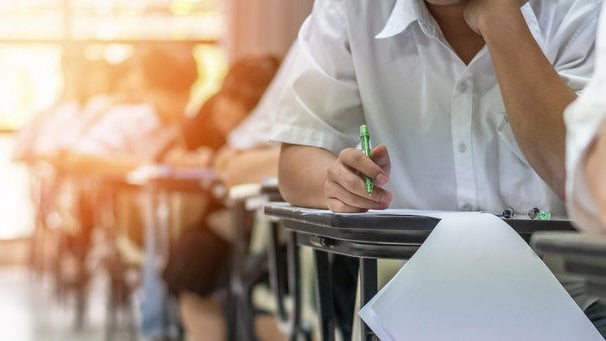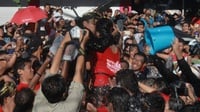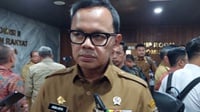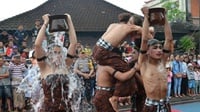tirto.id - Contoh soal PAT Bahasa Inggris kelas 11 semester 2 bisa dimanfaatkan siswa sebagai bahan belajar sebelum menghadapi ujian Penilaian Akhir Tahun. Selain peserta didik, guru dan tim pembuat soal ujian juga bisa memanfaatkan contoh soal Bahasa Inggris kelas 11 semester 2 sebagai referensi.
PAT merupakan salah satu komponen penilaian yang dilaksanakan pada akhir semester dua. Materi yang diujikan mencakup keseluruhan bab yang sudah dipelajari selama setahun di jenjang tertentu.
Hasil penilaian PAT kemudian akan diolah dan dianalisis untuk mengetahui ketuntasan belajar peserta didik. Selain nilai PAT, guru juga memiliki indikator lain untuk menentukan kenaikan kelas peserta didik.
Adapun jadwal PAT akan disesuaikan dengan kebijakan dinas pendidikan yang berlaku di tiap daerah. Setiap sekolah di Indonesia mungkin memiliki jadwal PAT yang berbeda, dan tidak akan diadakan secara bersamaan. Estimasi penyelenggaraan Penilaian Akhir Tahun diperkirakan akan dilakukan pada awal bulan Juni 2024.
Kisi-Kisi Soal UAS Bahasa Inggris Kelas 11 Semester 2
Mengenai mata pelajaran yang diujikan dalam PAT meliputi seluruh materi yang sudah dipelajari selama semester 2, termasuk Bahasa Inggris.
Adapun kisi-kisi soal UAS Bahasa Inggris kelas 11 semester 2, di antaranya meliputi sebagai berikut:
- Memahami gagasan utama surat pribadi
- Menemukan makna tersurat sebuah bacaan
- Menyimpulkan isi bacaan dari surat pribadi
- Memahami persamaan kata
- Menentukan ide pokok sebuah bacaan
- Menemukan informasi tertentu dari sebuah text explanation
- Mengidentifikasi sebuah informasi dalam teks explanation
- Memahami ide pokok sebuah bacaan ( explanation)
- Menyimpulkan sebuah informasi dari text explanation
- Menganalisis rujukan kata dari sebuah text
- Memahami persamaan kata
- Mengkorelasi kata dalam sebuah teks / melengkapi sebuah paragraf dalam teks explanation
- Menerapkan penggunaan konjungsi sebab akibat
- Menguraikan kalimat causeandeffect
- Mengidentifikasi isi atau tema sebuah lagu
- Mengidentifikasi tujuan dari sebuah lagu
- Menjelaskan jenis majas yang digunakan dalam sebuah lagu
- Menyimpulkan isi atau pesan dalam sebuah lagu
- Menentukan persamaan kata dalam sebuah lagu
- Menentukan antonim dari sebuah kata
- Menentukan informasi tersirat dalam sebuah lagu
Soal PAT Bahasa Inggris Kelas 11 Semester 2
Kumpulan contoh soal Bahasa Inggris kelas 11 semester 2 di bawah ini bisa digunakan oleh para siswa sebagai referensi belajar. Namun, disarankan agar siswa tetap mengacu pada materi yang terdapat dalam buku atau sumber pembelajaran lainnya guna mendalami pelajaran Bahasa Inggris dengan lebih baik.
Di bawah ini disajikan beberapa contoh soal PAT Bahasa Inggris kelas 11 semester 2. Soal-soal ini berkaitan dengan materi yang diajarkan dalam semester genap. Setiap contoh soal dilengkapi dengan jawaban yang sesuai.
Kumpulan Contoh Soal Bahasa Inggris Kelas 11 Semester 2
For questions No. 1 – 2
Apt BLK 30, Eunos St. #05 – 116
Singapore 1441
2nd April 2009
Dear Liza,
I have received your letter asking me to meet you at your house this Sunday to discuss the urgent matter you have. I regret however to say that it will not be possible for me to see you on Sunday as I already have a previous appointment . I shall see you on Monday next week at 5 p.m . Hoping the change of date will be convenient to you
Your sincerely
Daisy
1. What does the letter tell about ....
- A. Liza’s problem
- B. Liza’s appointment
- C. Daisy’s previous letter to Liza
- D. Daisy’s regret for not being able to come
- E. A meeting held at Liza’s house
2. Why did Liza ask Daisy to come to her house ....
- A. Liza wanted Daisy to solve her problem
- B. Daisy would discuss her problem with Liza
- C. Liza persuaded Daisy to go somewhere
- D. Daisy wanted to meet Liza’s family
- E. Liza wanted to chat with Daisy
For questions No. 3 – 5
Jl. Jambu 129
Bandung, 30th January 2017
Dear Fred,
It was a real sorrow that I heard this morning of your great loss. I knew your mother was ill. Your brother told me several weeks ago. However, as he at that time did not seem to think. The illness was very serious, the news of your mother’s death came to me as a shock. You have my sincere and heartfelt sympathy, my dear fellow, in your sorrow. I know you will feel it deeply, for you always thought so much of your mother and loved her so truly. I feel it also as a personal loss to myself for your mother was always very kind to me. I admired her a good and noble woman. Her death must be a terrible grief to your father too. Please assure him of my sincere sympathy.
Words, I know, are poor comforters. “The heart knows its own sorrow”, and in such sorrows we are always alone. However, it is not mere words when I say that I feel with you in your sorrow.
Your sincere friends,
Jack
3. What is the possible relation between the sender and the recipient?
- A. Relatives
- B. Employers
- C. Friends
- D. Siblings
- E. Employees
4. From the letter we know that ....
- A. Fred’s mother was not ill before her death
- B. Jack sent letter to Fred several weeks ago
- C. Jack was very sorrowful to send the letter to his mother
- D. Jack had known Fred’s mother before
- E. Fred is the only child in his family.
5. “You have my sincere and heartfelt sympathy, my dear fellow, in your sorrow.” What is the closest meaning of the underlined word?
- A. Real
- B. Caring
- C. Generous
- D. Honest
- E. Curious
For questions No. 6 – 8
To,
Tumer and family,
D-14, Galaxy apartments,
Manhattan.
Dear Tumers.
That’s looks really bizarre to make a communication In race or this letter with neighbors. However, the occasion makes this letter imminent. This letter marks the end or a very comfortable and desirable first year In this apartment. And, we have been proud aswell as blessed to have a neighbor like you all. The moment when we moved into this place, it was very awkward for us to adjust in this new ambience. Should your neighborhood been absent, then the awkward situation would never have been overcome.
In all the tomes, whether being the festive tomes or during the testing times, you have always backed us on all our decision. You made us acknowledge the fact that, neighbors are the rnt locome to helping any situation and all the relmives, friends come later. I would like to exploit this opportunity to appreciate your presence all with us. Thanking you.
Yours sincerely.
Robert Morgan
6. What is the purpose of the letter?
- A. To invite a neighbor.
- B. To introduce a neighbor.
- C. To celebrate a neighbor.
- D. To describe a neighbor.
- E. To thank to a neighbor.
7. “However, the occasion makes this letter imminent.”
The underlined word has the closest meaning to…
- A. The writer’s neighbor is a weird person
- B. The writer’s neighbor is a stubborn person
- C. The writer’s neighbor is an arrogant person
- D. The writer’s neighbor is a very bad person
- E. The writer’s neighbor is a very helpful person
8. “However, the occasion makes this letter imminent.”The underlined word has the closest meaning to…
- A. prompt
- B. nearby
- C. quick
- D. proper
- E. precise
For questions No. 9 – 10!
Oktober, 26th, 2020
Dear Mamad
I received your letter explaining your inability to come here yesterday. As you know, I celebrated my birthday on October 23td without you. It was truly a great moment for me. The birthday party was arranged at our residence at 7pm.
My home was beautifully decorated by our friends. New curtains, flower-pots, some paintings, and posters looked so cool. I bought all I need for the party from the market. I invited all our close friends and relatives.
Oh! Do you know how I missed you on that day? But you had to be busy with your compulsions. Anyway, please convey my regards to your parents and thanks for your birthday card and gift you have sent to me.
Best regard,
Prabu
9. Why did Prabu write the letter?
- A. To explain her friend his inability to come to her birthday party
- B. To invite her friend to come to her birthday party
- C. To thank her friend for his birthday’s card and present
- D. To tell her happiness during her birthday party
- E. To describe the celebration of her birthday
10. What was the writer’s problem?
- A. The writer could not see Mamad on her birthday’s celebration
- B. The beautiful decoration was not arranged by all of her friends
- C. The writer did not celebrate her birthday luxuriously
- D. The writer’s friends did not give her any present
- E. The writer did not convey her regards to Mamad’s parents
11. The heat causes deeper water to boil much more violently.
The heat creates jets of steam and fountains of hot water.
-----------------
The appropriate conjunction to combine the sentences is ....
- A. but
- B. and
- C. so that
- D. either
- E. unless
12. Read the following sentences.
Many species of wildlife are becoming extinct, __________ the rain forests are being destroyed
- A. therefore
- B. since
- C. so
- D. consequently
- E. as a result
Read The Text and Answer The Following Question!
Jessy : Well it’s an amazing Sunday, isn’t it?
Justin : Yeahh it’s true, and this weekend will be our last amazing weekend.
Jessy : Why?
Justin : Because next week we're gonna have a final exam. Haa. I am afraid that I can’t pass the exam.
Jessy : No, you will. If you study with all of your effort, you will definitely pass the exam.
Justin : Hahaha .... yaah I know, I can get the best score because of my effort.
13. From the dialogue, we know that ....
- A. Justin has already passed because he studied hard
- B. Jessy will study with Justin because they are friends
- C. Justin will pass the exam if he studies hard
- D. Jessy will help Justin if he needs her
- E. Justin and Jessy will pass if they answer the exam
For questions No. 14 – 16!
Read the dialog below. And answer the following questions.
Anna : Hey, can I get my book back, please? The one that you borrowed from me last week? I need it.
Bryan : Oh, I'm sorry. I forgot to bring it because of my little brother. He made such a fuss this morning. Thanks to the new nanny who could finally handle him.
Anna : It's ok. Can you bring it back tomorrow? I need to read that book due to my assignments.
Bryan : Sure. I’ll bring it tomorrow.
14. From the dialogue, we know that ....
- A. Bryan need Anna’s book for his assignments
- B. Anna made such a fuss this morning
- C. Bryan little brother need to read Anna’s book
- D. Bryan borrow the book for tomorrow
- E. Bryan borrowed Anna’s book but he forgot to bring it
15. Why did Bryan forget to bring Anna’s book?
- A. Because of his little brother made such a fuss
- B. Because the new Nanny read that book
- C. Because of the new Nanny
- D. Because his little brother made such a fuss
- E. Because of Anna’s book
16. The connectors of cause and effect on the dialog are ....
- A. because, because of, due to
- B. because of, thanks to, due to
- C. thanks to, due to, because
- D. because, thanks to, since
- E. due to, because of, so
17. I love living in Australia .... the weather.
- A. Because
- B. As
- C. Due
- D. Since
- E. Because of
18. “He got to work really, really late “Cos he missed his train”. Which cause and effect word is ‘Cos short for?
- A. Due to
- B. As
- C. Neither
- D. Because
- E. Since
19. I prefer driving .... I am afraid of flying.
- A. Before
- B. In order to
- C. Because
- D. After
- E. So that
"How a Geyser Forms"
A geyser field is usually located in an area where there has been recent volcanic activity. There can be hundreds of geysers in a geyser field. Their positions depend on the system of channels underground.
Cold surface water seeps underground. It flows through cracks in nonporous rock (rock that does not soak up water) and collects in channels of porous rock (rock that soaks up water). The water is heated by hot rock, and it begins to expand and boil. Water at the top boils off or spills over. This reduces the pressure and causes deeper water to boil much more violently, creating jets of steam and fountains of hot water.
20. Tense that are used in the text above are ....
- A. past tense
- B. future tense
- C. present perfect
- D. present tense
- E. present continuous tense
21. The water is heated by hot rock, and it begins to expand and boil.
The underlined word has a similar meaning with.....
- A. achieve
- B. develop
- C. induce
- D. reduce
- E. enlarge
For questions No. 22 – 23!
Butterflies are insects that undergo a complete metamorphosis during their life cycle. They are born as eggs that hatch into larvae and then grow into pupas, before transforming into adults which are butterflies.
Adult female butterflies lay many almost-invisible eggs simultaneously on plants. These plants, later, will become a source food for the hatching eggs, called larvae. At the stage of larvae, the hatching eggs do not look like butterflies. The larvae of butterflies are called caterpillars. The only thing caterpillars do is eat. The food they eat will be stored and used when they become butterflies. During their growth before turning into pupas called chrysalises, they shed skin 4 to 5 times. When they are fully grown, they stop eating ant turn into pupas, hanging under branches, leaver or other hidden areas. Inside the pupas, the cells of caterpillars turn into parts of butterflies’ bodies. When the caterpillars come out their pupas, they have already transformed into butterflies. They have compound eyes and long antennae, and legs and wings. At the final stage of their life cycle, the jobs of butterflies are mating, and laying eggs to become the next caterpillars.
22. The purpose of the text is ....
- A. to amuse readers with a text about butterflies
- B. to persuade readers to like butterflies
- C. to present opinions about butterflies
- D. to tell the life cycle of butterflies
- E. to help readers catch butterflies
23. “Adult female butterflies lay many almost-invisible eggs at once on plants.”
(Paragraph 2) . The underlined word means ....
- A. cannot be destroyed
- B. cannot be hatched
- C. cannot be seen
- D. cannot be laid
- E. cannot fly
For questions No. 24—25!
Don’t Cry For Me Argentina
Don't cry for me Argentina
The truth is I never left you
All through my wild days
My mad existence
I kept my promise
Don't keep your distance
24. The song is about ....
- A. lovers
- B. freedom
- C. nationality
- D. woman’s right
- E. world peace
25. The message of the song is ....
- A. The people of Argentina do not mourn their leader’s death.
- B. The song writer doesn’t want to cry.
- C. People in argentina have to keep their promise.
- D. The people should not keep the distance.
- E. People should be happy of their leader’s death.
For questions No. 26 – 28!
Human body is made up of countless millions of cells. Food is needed to built up new cells and replace the worn out cells. However, the food that we take must be changed into substances that can be carried in the blood to the places where they are needed. This process is called digestion.
The first digestive process takes place in the mouth. The food we eat is broken up into small pieces by the action of teeth, mixed with saliva, a juice secreted by glands in the mouth. Saliva contains digestive juice which moisten the food, so it can be swallowed easily.
From the mouth, food passes through the esophagus (the food passage) into the stomach. Here, the food is mixed with the juices secreted by the cells in the stomach for several hours. Then the food enters the small intestine. All the time the muscular walls of the intestine are squeezing, mixing and moving the food onwards.
In a few hours, the food changes into acids. These are soon absorbed by the villi (microscopic branch projections from the intestine walls) and passed into the bloodstream.
26. What is the text about?
- A. The digestive system
- B. The digestive juice
- C. The method of the digestive system
- D. The process of intestine work
- E. The food substances
27. From the text above, we imply that ....
- A. a good process of the digestive system will help our body become healthier.
- B. no one concerned with the process of the digestive system for their health.
- C. the digestive system is needed if we are eating the food instantly.
- D. everybody must conduct the processes of digestive system well.
- E. the better we digest the food we eat, the healthier we will be
28. Human body is made up of countless millions of cells. (Paragraph 1)
The phrase made up means ....
- A. Produced
- B. Managed
- C. Arranged
- D. Completed
- E. Constructed
For questions No. 29 – 30!
A cell phone is a great gadget in this modern world. What is a cell phone? A cell phone is actually a radio in certain way. Like a radio, by a cell phone we can communicate to other people in real time. Million people use cell phone for their communication. Even nowadays, people use cell phones to communicate in voice, written and data. Alexander Graham Bell is the person who make great change in the way people communicate to each other. He invented a telephone in 1876. While wireless radio was formally known in 18994 presented by Guglielmo Marconi. By these two technologies, then a cell phone was born. However do you know how actually cell phones work?This short explanation on how a cell phone work is really wonderful. A cell phone or in long term “cellular telephone’ works by transmitting signals of radio to towers of cellular.
The towers are networked to a central switching station. The connection usually uses wire, fiber optic-cables, or microwave.
Then the central switching station which handles calls in certain given area is directed connected to the wire-based telephone system. Cellulars are pick up by the towers and relayed to another cellular telephone user or the user of wire-based telephone network. The towers vary in the capacity and capability to receive signals. Some can receive the signal from short distance and the others can receive more distance. However, there are usually more than one tower in certain given area so that the system can handle the increasing telephone traffic
29. What the text about ....
- A. The telephone founder
- B. The part of telephone
- C. The history of telephone
- D. How telephone work
- E. How much the telephone
30. What is the main idea of paragraph three ....
- A. How to use the telephone
- B. The founder of telephone
- C. The part of telephone
- D. Function of telephone
- E. How to make the telephone
31. Once upon a time the cat bit the mouse's tail off. “Give me back my tail,” said the mouse. And the cat said, “Well, I ..... you back your tail if you fetched me some milk. But that's impossible to do for a little mouse like you.”
- A. Wouldgive
- B. Gave
- C. Have given
- D. Will give
- E. Am giving
32. The mouse, however, went to the cow. “The cat ..... me back my tail if I fetch her some milk.”
- A. Will only give
- B. Only gave
- C. Would be given
- D. Would only give
- E. Will have given
33. And the cow said, “Well, I would give you milk if you ..... me some hay. But that's impossible to do for a little mouse like you.”
- A. Would get
- B. Would have given
- C. Got
- D. Will get
- E. Will have given
34. The mouse, however, went to the farmer. “The cat will only give me back my tail if the cow ..... me some milk. And the cow ..... me milk if I get her some hay.”
- A. Have given, would only have given
- B. Gave, would only gave
- C. Gave, would only give
- D. Give, only gives
- E. Gives, will only give
35. The mouse promised not to steal, and so the baker gave the mouse bread, the mouse gave the butcher bread. The butcher gave the mouse meat; the mouse gave the farmer meat. The farmer gave the mouse hay; the mouse gave the cow hay. The cow gave the mouse milk; the mouse gave the cat milk. And the cat gave the mouse her tail back. But imagine what would have happened otherwise: If the mouse .....never to steal corn or meal, the baker would not have given the mouse bread.
- A. Has not promised
- B. Had not promised
- C. Have not promised
- D. Is not promised
- E. Was not promised
36. Find the FACT of this sentence:
If I had found her address, I would have sent her an invitation.
- A. I want to send an invitation to a friend but I can't find her address. So, in the end, I still send her an invitation.
- B. I wanted to send an invitation to a friend but I didn't find her address. So, in the end, I didn't send her an invitation.
- C. I wanted to send an invitation to a friend and I could find her address. So, in the end, I sent her an invitation.
- D. I want to send an invitation to a friend and I find her address. So, I send her an invitation.
- E. I want to send an invitation to a friend but I can't find her address. So, in the end, I don't send her an invitation.
37. Based on the fact below, find the right Conditional Sentence:
I would like to send an invitation to a friend. I have looked everywhere for her address, but I cannot find it. So now, I think it is rather unlikely that I will eventually find her address.
- A. Would send her an invitation if I had found her address.
- B. Would send her an invitation if I have found her address.
- C. I would have sent her an invitation if I have found her address.
- D. I would have sent her an invitation if I found her address.
- E. I would send her an invitation if I found her address.
38. Which of the following sentences is written in passive voice?
- A. Over half of the graduating class went to college in the fall.
- B. The state exam was passed by over half of the students who took it.
- C. The committee is considering a public transportation proposal.
- D. The researchers will publish their findings in a report.
- E. She closed the door slowly
Quations no 39 - 42!
Read the text to answer the question.
Snakes are reptiles (cold-blooded creatures). They belong to the same group as lizards (the scaled group, Squamata) but from a sub-group of their own (Serpentes).
Snakes have two legs but a long time ago they had claws to help them slither along. Snakes are not slimy. They are covered in scales which are just bumps on the skin. Their skin is hard and glossy to reduce friction as the snake slithers along the ground.
Snakes often sun bathe on rocks in the warm weather. This is because snakes are cold-blooded; they need the sun’s warmth to heat their bodies up. Most snakes live in the country. Some types of snakes live in tress, some live in water, but most live on the ground in deserted rabbit burrows, in thick, long grass and in old logs. A snake’s diet usually consists of frogs, lizard, and mice and other snakes.
The Anaconda can eat small crocodiles and even bears. Many snakes protect themselves with their fangs. Some snakes are protected by scaring their enemies away like the Cobra. The flying snakes glide away from danger. Their ribs spread apart and the skin stretches out. Its technique is just like the sugar gliders.
39. Since the snakes are cold-blooded, they .....
- A. Like sucking the cool blood
- B. Avoid sun-bathing to their skins
- C. Never sun bathe in the warm weather
- D. Live on the ground in deserted burrows
- E. Require the sun’s warmth to heat their bodies
40. We know from the text that snakes .....
- A. Do not have claws
- B. Do not like sunlight
- C. Have two legs and claws
- D. Use their legs to climb the tree
- E. Use their claws to slither along the ground
41. Some types of snakes live in tress, some live in water, but most live on the ground in deserted rabbit burrows, .....(paragraph 4).The word “burrows “ has the similar meaning with .....
- A. Foster
- B. Dig
- C. Plough
- D. Nurture
- E. Cultivate
42. How do flying snakes protect themselves .....
- A. They fly away
- B. They use their fangs they scare their enemies
- C. They stretch out their skin
- D. They eat the other animals
- E. Sun bathe on rocks
Quations no 43 - 45!
Read the text to answer the question!
Ant-eaters are perhaps the most curious looking animals. Their long head and snout look like tubes, and they have no teeth at all. Their front legs are very strong and armed with heavy curved claws with which they break open the nets of ants and termites and then, when the insects rush out, use their long, sticky tongues to lick them up at great speed. True ant-eaters are found in the swamps and forests of central and South America. Scaly ant-eaters, or pangolins, are found in Africa and tropical Asia. Various other insect-eating animals are sometimes called ant-eaters, although they really belong to other groups of animals. One of them is the ant-bear, which lives on the plains of South and Central Africa. This has long, erect ears but short blunt claws, an almost hairless tail, yellow brown in color. Unlike the true ant-eaters, it has small teeth.
43. The text tells us .....
- A. The story of ant-eaters
- B. The report of ant-eaters
- C. The discussion of ant-eaters
- D. The description of ant-eaters
- E. The explanation of ant-eater’s body
44. What is the ant-bear?
- A. The animal has long, erect ears and small teeth
- B. The animal looks like a pangolin
- C. The animal has no sticky tongue
- D. The animal does not like to eat ants
- E. The animal belongs to ants’ group
45. From the passage above, we can conclude that .....
- A. All ants are friends of other insects
- B. Ants live in the disgusted places
- C. Ants are classified as predators
- D. Ants belong to the insect group
- E. Ants usually eat death animal
Quations no 46 - 50!
Read the text to answer the question
An elephant is the largest and strongest animals. It is a strange looking animal with its thick legs, huge sides and backs, large hanging ears, a small tall, little eyes, long white tusks and above all it has a long noise, the trunk. The trunk is the elephant’s peculiar feature, and it has various uses. The elephant draws up water by its trunk and can squirt it all over its body like a shower bath. It can also lift leaves and puts them into its mouth. In fact the trunk serves the elephant as a long am and hand. An elephant looks very clumsy and heavy and yet it can move very quickly.
The elephant is a very intelligent animal. Its intelligence combined with its great strength makes it a very useful servant to man and it can be trained to serve in various ways such as carry heavy loads, hunt for tigers and even fight.
46. The text tells us about .....
- A. The Elephant’s peculiar feature
- B. Useful servant
- C. Strange looking animal
- D. An elephant
- E. Elephant looks very clumsy
47. The last paragraph is mainly about the fact that.....
- A. Elephants are strong
- B. Elephants can lift logs
- C. Elephants are servants
- D. Elephant are very useful
- E. Elephant must be trained
48. The most distinguishing characteristic of an elephant is .....
- A. Its clumsiness
- B. Its thick legs
- C. Its large body
- D. Its long nose
- E. Its large ears
49. Which of the following is NOT part of the elephant described in the first paragraph ?
- A. It looks strange
- B. It is heavy
- C. It is wild
- D. It has a trunk
- E. It has a small tail
50. The elephant draws up water by its trunk and can squirt it all over its body like a shower bath (paragraph 2). The word “it” refers to .....
- A. A shower bath
- B. Elephant’s body
- C. A shower
- D. Water
- E. Elephant’s trunk
Kunci Jawaban PTS Bahasa Inggris Kelas 11 Semester 2
Berikut ini kunci jawaban PTS Bahasa Inggris kelas 11 semester 2 dari 50 contoh soal di atas.
- D
- A
- C
- A
- D
- E
- E
- B
- E
- A
- B
- A
- C
- B
- D
- B
- E
- D
- C
- D
- E
- D
- C
- B
- C
- A
- A
- E
- C
- C
- A
- A
- C
- E
- B
- B
- E
- B
- E
- E
- B
- A
- B
- A
- C
- D
- D
- D
- A
- E
Penulis: Nurul Azizah
Editor: Fadli Nasrudin
Penyelaras: Ibnu Azis












